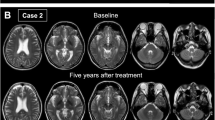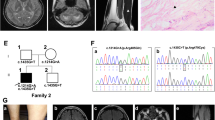Abstract
Of the primary dementing disorders that cause frontotemporal dementia, the best-known is Pick disease. We report on a 44-year-old woman with progressive frontal lobe dementia and spastic paraplegia. Examination revealed increased serum levels of cholestanol with abnormal cholesterol metabolism and a heterozygous mutation of the sterol 27-hydroxylase gene (CYP27). Biochemical findings were compatible with cerebrotendinous xanthomatosis (CTX); however, the clinical manifestations were very dissimilar. To our knowledge, a symptomatic carrier of this mutation among CTX patients has not been reported. We speculate that the present patient has a previously undescribed neurodegenerative disease related to abnormal cholesterol metabolism with this heterozygous mutation.
Similar content being viewed by others
REFERENCES
Aikawa H, Suzuki K, Iwasaki Y, Iizuka R (1985) Atypical Alzheimer's disease with spastic paresis and ataxia. Ann Neurol 17: 297-300.
Beppu T, Seyama Y, Kasama T, Serizawa S, Yamakawa T (1982) Serum bile acid profiles in cerebrotendinous xanthomatosis. Clinica Chimica Acta 118: 167-175.
Berginer VW, Foater NL, Sadwsky M, Townsend JA, Siegel GJ, Salen G (1988) Psychiatric disorders in patients with cerebrotendinous xanthomatosis. Am J Psychiatry 145: 354-357.
Berginer VM, Berginer J, Korczyn AD, Tadmor R (1994) Magnetic resonance imaging in cerebrotendinous xathomatosis: a prospective clinical and neuroradiological study. J Neurol Sci 122: 102-108.
Bjorkhem I, Boberg KM (1995) Inborn errors in bile acid biosynthesis and storage of sterols other than cholesterol. In Scriver CR, Beaudet AL, Sly WS, Valle D, eds. The Metabolic and Molecular Basis of Inherited Disease, 7th edn. New York: McGraw Hill, 2073-2099.
Cali JJ, Hsieh CL, Francke U, Russell DW (1991) Mutations in the bile acid biosynthetic enzyme sterol 27-hydroxylase underlie cerbrotendinous xanthomatosis. J Biol Chem 266: 7779-7783.
Chen W, Kubota S, Kim K-S, et al (1997) Novel homozygous and compound heterozygous mutations of sterol 27-hydroxylase gene (CYP27) cause cerebrotendinous xanthomatosis in three Japanese patients from two unrelated families. J Lipid Res 38: 870-879.
Dotti MT, Salen G, Federico A (1991) Cerebrotendinous xanthomatosis as multisystemic disease mimicking premature aging. Dev Neurosci 13: 371-376.
Federico A, Dotti MT (1996) Cerebrotendinous xanthomatosis. In Moser HW, ed. Handbook of Clinical Neurology, vol. 22. Amsterdam: Elsevier Science, 599-613.
Gregory CA, Hodges JR (1996) Clinical features of frontal lobe dementia in comparison to Alzheimer's disease. J Neural Transm 47: 103-123.
Gustafson L, Nilsson L (1982) Differential diagnosis of presenile dementia on clinical grounds. Acta Psychiatr Scand 65: 194-209.
Kasama T, Byun DS, Seyama Y (1987) Quantitative analysis of sterols in serum by high-performance liquid chromatography. Application to the biochemical diagnosis of cerebrotendinous xanthomatosis. J Chromatogr 400: 241-246.
Kim KS, Kubota S, Kuriyama M, et al (1994) Identification of new mutations in sterol 27-hydroxylase gene in Japanese patients with cerebrotendinous xathomatosis. J Lipid Res 35: 1031-1039.
Kimura A, Mahara R, Inoue T, et al (1999) Profile of urinary bile aids in infants and children: developmental pattern of excretion of unsaturated ketotic bile acids and 7β-hydroxylated bile acids. Pediatr Res 45: 603-609.
Kitamoto T, Amano N, Terao Y, et al (1993) A new inherited prion disease (PrP-P105L mutation) showing spastic paraparesis. Ann Neurol 34: 808-813.
Kuwabara M, Ushiroguchi T, Kihira K, Kuramoto K, Hoshita T (1984) Identification of bile alcohols in urine from healthy humans. J Lipid Res 24: 361-368.
Lanska DJ, Currier MS, Cohen M, et al (1994) Familial progressive subcortical gliosis. Neurology 44: 1633-1643.
Leitersdorf E, Safadi R, Meiner V, et al (1994) Cerebrotendinous xanthomatosis in the Israeli Druze: molecular genetics and phenotypic characteristics. Am J Hum Genet 55: 907-915.
Mann DMA (1998) Dementia of frontal type and dementias with subcortical gliosis. Brian Pathol 8: 325-338.
Meiner V, Meiner Z, Reshef A, Bjorkhem I, Leitersdrof E (1994) Cerebrotendinous xanthomatosis: molecular diagnosis enables presymptomatic detection of a treatable disease. Neurology 44: 288-290.
Mitsuyama Y, Takamiya S (1979) Presenile dementia with motor neuron disease in Japan. Arch Neurol 36: 592-593.
Nakagawa M, Une M, Takenaka S, Kuramoto T, Abukawa D, Iinuma K (1999) Urinary bile alcohol profile in infants with intraheptic cholestasis: identification of 5β-cholestane-3α,7α,24,25-tetrol. Acta Paediatr 88: 1078-1082.
Neary D, Snowden JS, Gustafson L, et al (1998) Frontotemporal lobar degeneration. A consensus on clinical diagnostic criteria. Neurology 51: 1546-1554.
Russell DW, Setchell DR (1992) Bile acid biosynthesis. Biochemistry 31: 4737-4749.
Shapiro S (1983) Depression in a patient with dementia secondary to cerebrotendinous xanthomatosis. J Nerv Ment Dis 171: 568-571.
Skrede S, Bjorkhem I, Kvittingen EA, et al (1986) Demonstration of 26-hydroxylation of C27-steroids in human skin fibroblasts, and a deficiency of this activity in cerebrotendinous xanthomatosis. J Clin Invest 78: 729-735.
Spillantini MG, Bird TD, Ghetti B (1998) Frontotemporal dementia and Parkinsonism linked to chromosome 17: a new group of taunopathies. Brain Pathol 8: 387-402.
Suzuki M, Murai T, Yoshimura T, Kimura A, Kurosawa T, Tohma M (1997) Determination of 3-oxo-Δ4-and 3-oxo-Δ4:6-bile acids and related compounds in biological fluids of infants with cholestasis by gas chromatography-mass spectrometry. J Chromatogr B 693: 11-21.
Swanson PD, Cromwell LD (1986) Magnetic resonance imaging in cerebrotendinous xanthomatosis. Neurology 36: 124-126.
Talbot PR (1996) Frontal lobe dementia and motor neuron disease. J Neural Transm 47: 1125-1132.
Yamada M, Satoh S, Sodeyama N, et al (1995) Spastic paraparesis and mutations in the prion protein gene. J Neurol Sci 134: 215-216.
Author information
Authors and Affiliations
Rights and permissions
About this article
Cite this article
Sugama, S., Kimura, A., Chen, W. et al. Frontal lobe dementia with abnormal cholesterol metabolism and heterozygous mutation in sterol 27-hydroxylase gene (CYP27). J Inherit Metab Dis 24, 379–392 (2001). https://doi.org/10.1023/A:1010564920930
Issue Date:
DOI: https://doi.org/10.1023/A:1010564920930




